molar pregnancy













The hydatidiform moles are one of the most common but benign forms of gestational trophoblastic disease.
Epidemiology
Hydatidiform moles are one of the common complications of gestation, estimated to occur in one of every 1,000-2,000 pregnancies . These moles can occur in a pregnant woman of any age, but the rate of occurrence is higher in pregnant women in their teens or between the ages of 40-50 years. There is a relatively increased prevalence in Asia (for example compared with Europe).
Pathology
Subtypes
A hydatidiform mole can either be complete or partial. The absence or presence of a fetus or embryo is used to distinguish the complete from partial moles:
- complete moles are associated with the absence of a fetus
- partial moles usually occur with an abnormal fetus or may even be associated with fetal demise
Rarely, moles co-exist with a normal pregnancy (co-existent molar pregnancy), in which a normal fetus and placenta are seen separate from the molar gestation.
Chromosomal composition
Ninety percent of complete hydatidiform moles have a 46XX diploid chromosomal pattern. All the chromosomes are derived from a single sperm in 90% or less likely two sperms, suggesting fertilization of a single egg that has lost its chromosomes.
With partial moles, the karyotype is usually triploid (69XXY), the result of fertilization of a normal egg by two sperm, one bearing a 23X chromosomal pattern and the other a 23Y chromosomal pattern.
Location
Complete hydatidiform moles usually occupy the uterine cavity and are rarely located in fallopian tubes or ovaries.
The chorionic villi are converted into a mass of clear vesicles that resemble a cluster of grapes.
Markers
In the classic case of molar pregnancy, quantitative analysis of beta-HCG shows hormone levels in both blood and urine greatly exceeding those produced in normal pregnancy at the same stage.
Radiographic features
Please refer to the dedicated articles for discussion on the radiographic features:
Treatment and prognosis
A complete mole can progress to invasive mole (~15%) or to gestational choriocarcinoma (~7%).
See also
Siehe auch:
- gestational trophoblastic disease
- partial hydatidiform mole
- complete hydatidiform mole
- gestational choriocarcinoma
- invasive mole
- bunch of grapes
- mesenchymale Dysplasie der Plazenta
- ovarian theca lutein cysts
- abnormal high beta-HCG level
- co-existant molar pregnancy
und weiter:

 Assoziationen und Differentialdiagnosen zu Blasenmole:
Assoziationen und Differentialdiagnosen zu Blasenmole:



